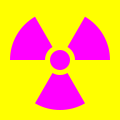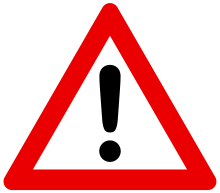Hazard symbol

Hazard symbols are recognizable symbols designed to warn about hazardous materials, locations, or objects, including electric currents, poisons, and other things. The use of hazard symbols is often regulated by law and directed by standards organizations. Hazard symbols may appear with different colors, backgrounds, borders and supplemental information in order to specify the type of hazard.
Types of hazard symbols
| Name hazard symbol | Symbol | Unicode | Image |
|---|---|---|---|
| General caution | ☡ | U+2621 |  |
| Poisonous sign | ☠ | U+2620 |  |
| Radioactivity sign | ☢ | U+2622 |  |
| Ionizing radiation sign | ? | ? |  |
| Non-ionizing radiation sign | ? | ? |  |
| Biohazard sign | ☣ | U+2623 |  |
| Warning sign | ⚠ | U+26A0 |  |
| High voltage sign | ⚡ | U+26A1 |  |
| Chemical weapon symbol |  | ||
| Laser hazard sign | ? | ? |  |
Poison sign

The skull-and-crossbones symbol (☠), consisting of a human skull and two bones crossed together behind the skull, is today generally used as a warning of danger, particularly in regard to poisonous substances.
The symbol, or some variation thereof, specifically with the bones (or swords) below the skull, was also featured on the Jolly Roger, the traditional flag of European and American seagoing pirates. It is also part of the Canadian WHMIS home symbols placed on containers to warn that the contents are poisonous.
In the United States, due to concerns that the skull-and-crossbones symbol's association with pirates might encourage children to play with toxic materials, the Mr. Yuk symbol is also used to denote poison.
Radioactive trefoil symbol



The international radiation symbol (also known as trefoil) first appeared in 1946, at the University of California, Berkeley Radiation Laboratory.[citation needed] At the time, it was rendered as magenta, and was set on a blue background.[1] (See right.) The modern version used in the US is magenta against a yellow background, and it is drawn with a central circle of radius R, an internal radius of 1.5R and an external radius of 5R for the blades, which are separated from each other by 60°. The trefoil is black in the international version, which is also acceptable in the US.[2]

On February 15, 2007, two bodies—the International Atomic Energy Agency (IAEA) and the International Organization for Standardization (ISO)—jointly announced the adoption of a new ionizing radiation warning symbol to supplement the traditional trefoil symbol. The new symbol, to be used on sealed radiation sources, is aimed at alerting anyone, anywhere to the danger of being close to a strong source of ionizing radiation.[3] It depicts, on a red background, a black trefoil with waves of radiation streaming from it, along with a black skull and crossbones, and a running figure with an arrow pointing away from the scene. The radiating trefoil suggests the presence of radiation, while the red background and the skull and crossbones warn of the danger. The figure running away from the scene is meant to suggest taking action to avoid the labeled material. The new symbol is not intended to be generally visible, but rather to appear on internal components of devices that house radiation sources so that if anybody attempts to disassemble such devices they will see an explicit warning not to proceed any further.[4][5]
Biohazard sign

Developed by the Dow Chemical Company in 1966 for their containment products.[6]
According to Charles Baldwin,[6] an environmental-health engineer who contributed to its development: "We wanted something that was memorable but meaningless, so we could educate people as to what it means." In an article in Science in 1967, the symbol was presented as the new standard for all biological hazards ("biohazards"). The article explained that over 40 symbols were drawn up by Dow artists, and all of the symbols investigated had to meet a number of criteria: "(i) striking in form in order to draw immediate attention; (ii) unique and unambiguous, in order not to be confused with symbols used for other purposes; (iii) quickly recognizable and easily recalled; (iv) easily stenciled; (v) symmetrical, in order to appear identical from all angles of approach; and (vi) acceptable to groups of varying ethnic backgrounds." The chosen scored the best on nationwide testing for memorability.[7]
It is used in the labeling of biological materials that carry a significant health risk, including viral samples and used hypodermic needles.
Drawing
All parts of the biohazard sign can be drawn with a compass and straightedge. The basic outline of the symbol is a plain trefoil, which is three circles overlapping each other equally like in a triple Venn diagram with the overlapping parts erased. The diameter of the overlapping part is equal to half the radius of the three circles. Then three inner circles are drawn in with ⅔ radius of the original circles so that it is tangent to the outside three overlapping circles. A tiny circle in center has a diameter ½ of the radius of the three inner circles, and arcs are erased at 90°, 210°, and 330°. The arcs of the inner circles and the tiny circle are connected by a line. Finally, the ring under is drawn from the distance to the perimeter of the equilateral triangle that forms between the centers of the three intersecting circles. An outer circle of the ring under is drawn and finally enclosed with the arcs from the center of the inner circles with a shorter radius from the inner circles.[2]
Warning sign

On warning signs, an exclamation mark is often used to draw attention to a warning of danger, hazards, and the unexpected. In Europe, this type of sign is used if there are no other appropriate signs to denote a hazard.[8] When used in traffic signs a plate describing the hazard must be present. On an upright sign it is usually mounted under the exclamation mark.
Chemical hazard
A chemical hazard label is a pictogram applied to containers of dangerous chemical compounds to indicate the specific risk, and thus the required precautions. There are several systems of labels, depending on the purpose (container for handling, container for transportation).
GHS chemical hazard symbols and statements
European chemical hazard symbols
In Europe, a standard is used, as fixed - by the CLP regulation(2008) for the chemical container, that follows the GHS recommendations; see European CLP/GHS hazard symbols.
| Examples of European warning for flammable substances: |  |
 |
 | ||

- by the European Agreement concerning the International Carriage of Dangerous Goods by Road(ADR) for additional packaging for the transportation. Vehicles carrying dangerous goods have to be fitted with orange signs, where the lower number identifies the substance, while the upper number is a key for the threat it may pose. These symbols cannot be readily interpreted without the aid of a key.
Canada chemical hazard symbols

US chemical hazard symbols
(TSCA, US regulations)The US-based National Fire Protection Association (NFPA) has a standard NFPA 704 using a diamond with four colored sections each with a number indicating severity 0—4 (0 for no hazard, 4 indicates a severe hazard). The red section denotes flammability. The blue section denotes health risks. Yellow represents reactivity (tendency to explode). The white section denotes special hazard information. One example of a special hazard would be the capital letter W crossed out (pictured right) indicating it is water reactant. This label is used primarily in the US.
Other countries hazard symbols
Non-standard warning signs

English: When you climb over the fence, you are in danger of death! The tower and the cables are high voltage!
A large number of warning signs of non-standard designs, are in use around the world. An example is the one on the right at the Beromünster Reserve Broadcasting Tower.
See also
- GHS hazard pictograms, part of the United Nations Globally Harmonized System of Classification and Labelling of Chemicals
- International Standard ISO 3864: Graphical symbols—Safety colours and safety signs.
- NFPA 704 Fire Diamond
- Pictogram
- British Standard BS 5499: Graphical symbols and signs
- Canada's Workplace Hazardous Materials Information System
- Warning sign
- Dangerous goods
References
- ↑ "Origin of the Radiation Warning Symbol (Trefoil)".
- ↑ 2.0 2.1 "Biohazard and radioactive symbol, design and proportions".
- ↑ This symbol is included in ISO 21482:2007. ISO International Standards are protected by copyright and may be purchased from ISO or its members (please visit www.iso.org for more information). ISO has not reviewed the accuracy or veracity of this information. "New Symbol Launched to Warn Public About Radiation Dangers". Retrieved 2007-02-15.
- ↑ "New Symbol Launched to Warn Public About Radiation Dangers". IAEA. Retrieved 2010-12-20.
- ↑ "Deccan Herald – Drop it".
- ↑ 6.0 6.1 "Biohazard Symbol History". Archived from the original on July 16, 2011.
- ↑ Baldwin, CL; Runkle, RS (Oct 13, 1967). "Biohazards symbol: development of a biological hazards warning signal.". Science 158 (3798): 264–5. doi:10.1126/science.158.3798.264. PMID 6053882. Retrieved 29 August 2011.
- ↑ "A series european traffic signs".
External links
| Wikimedia Commons has media related to Hazard signs. |
| Wikimedia Commons has media related to DIN 4844-2 warning signs. |
- Hazchem Guide from The National Chemical Emergency Centre
- European Chemicals Bureau
- Directive 2001/59/EC
- Hazchem panel information
| |||||||||||||||||||||||||||||
